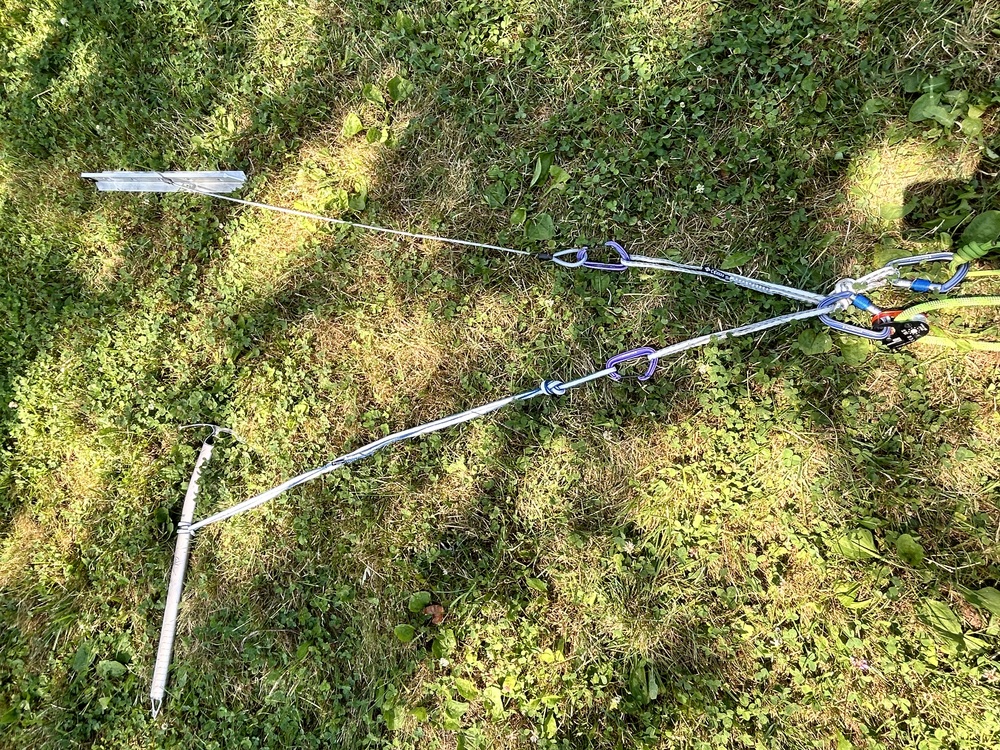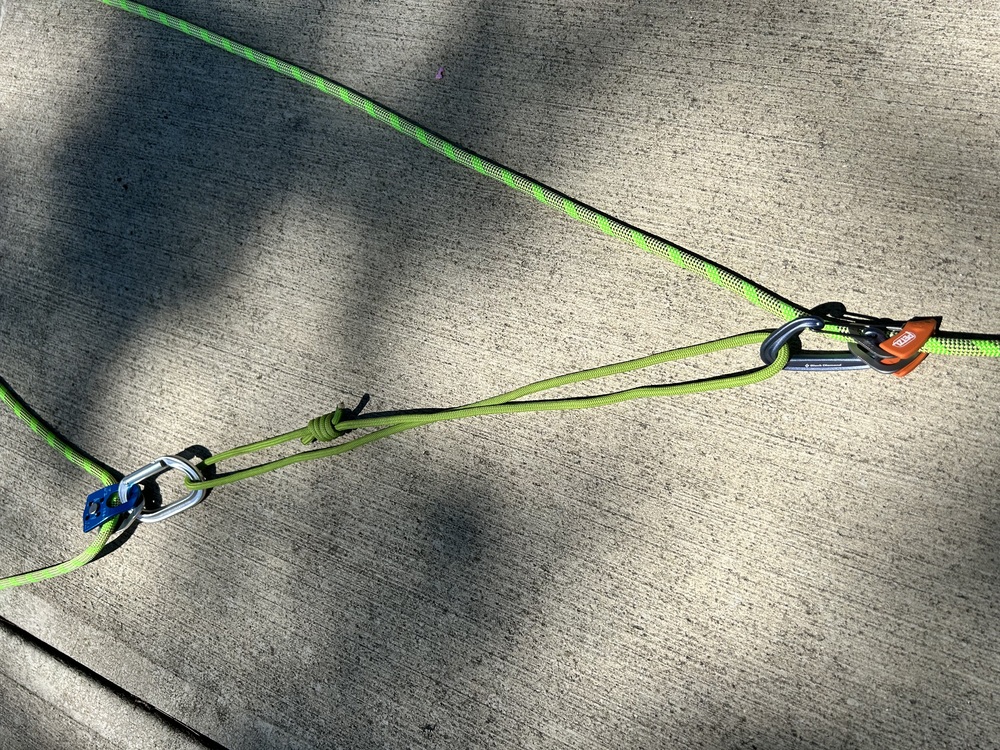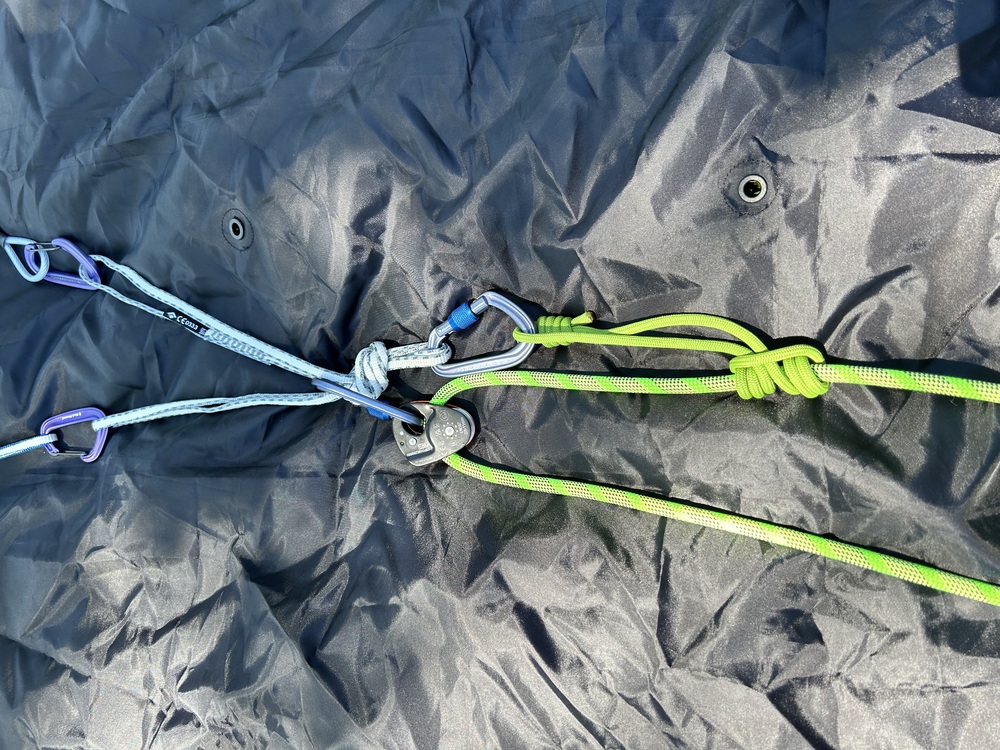Crevasse rescue setup
|
|
Have a trip coming up in August and it’s been a hot minute and wanted to see if my set up is correct. I threw it together right quick in my yard, nothing is weighted and I’ll probably be using a couple pickets or and for dead man. |
|
|
Lots of possibilities here. If you can add some of the information below, it will help guide the commentary.
Sounds like fun. Planning is good. |
|
|
just a few minor thoughts on the system you presented:
in a broader context, i'm generally more of a fan of starting with a 2:1, then adding MA if needed. if my partner falls in and is unhurt, the 2:1 allows them to assist on the haul. 3:1 means i do all the work (and i'm lazy). it's also easy to add MA to a drop c. of course, this is all situation dependent, so good to have a few tools in the toolbox. |
|
|
So the trip right now is a planned 3 man on Rainier going up in late August. Starting to get a vibe our 3rd might bail on us. So could potentially turn into a 2 man. Just heading up the DC route. If I removed the prusik would dropping the micro to that position be ok? My thought process was the prusik, I could take weight off somewhat while still constructing the second anchor. Especially if it turns into a 2 man team. I also noticed that I did place my tribloc on upside down in that picture but had corrected it before posting. |
|
|
Its difficult to see your whole system as there is no overall picture, but glancing through your photos I see two fundamental issues: First, it is difficult to understand how you intent to accomplish the process of arresting a fall and transferring the load onto the anchor. It appears to be a Z drag set up in isolation of the events preceding it, so it is hard to give a pass/fail on the overall process. When I think of what would be necessary to get to the set up you have, I can think of multiple better options. Second, it is riddled with fairly small detail errors that while not always critical, are still somewhat problematic. A couple examples would be: - The knot in the 120 cm sling off of the axe: what is that for? It does not provide any redundancy or strength (actually reduces strength). If you needed to tie a knot to effectively shorten the length of the sling, and clip in behind that knot, that would be acceptable, but an overhand in a sling like that is absolutely unnecessary and will only make life more difficult when you need to untie it. - The whole second sling creating the master point of your anchor: unnecessary and will only take time and materials to construct. As you will see in the video series I will discuss later, it is generally better and more feasible to arrest the fall and transfer the load onto the first element of your anchor, and then create an effective backup to that anchor, rather than creating a whole equalized anchor and then transferring the load to it. Good luck trying to create that anchor while taking all the weight of your victim the whole time. Finally, even if you did want to create an equalized anchor off the bat, you could easily do it by clipping the picket cable and sling off of the axe together, no need to add yet another sling and 2 carabiners - its just more materials that could be better used elsewhere. - As mentioned before, you incorrectly clipped the microtrax to the anchor shelf. If either component of your anchor failed, that microtrax would fail. This demonstrates some fundamental misapplication of anchor components, and is probably the single biggest technical error in your pictures. Yes, your prussic is there as a backup and clipped correctly to your "master point" but... - As mentioned before, no need to use a prussic to back up the microtrax. First, a prussic like that is not considered the hard backup that you ideally want in your system, and second it will only make things more complicated/difficult. - The long sling between your tiblock and pulley - it is entirely unnecessary, takes more materials, and is actually reducing your efficiency in movement of your system by shortening your pull length/throw. Clip the pulley directly to the tiblock carabiner. Ok, after that fairly pointed critique, I do want to offer some resources to help you be successful in your Rainier bid. This AMGA Crevasse Rescue Drill overview by Outdoor Research is a wonderful resource for learning the different components of an effective crevasse rescue. It covers everything from roping up, creating anchors, descending and ascending out of a crevasse to aid an incapacitated victim, and hauling the victim out of the crevasse. It is based off of the drop C method, which has a lot of advantages, including facilitating using knots in your rope between you and your partner (highly advised, especially if it is a team of 2), and is quick and flexible to adapt to different stages in the rescue and mechanical advantages. The one disadvantage is that it does take a fairly significant amount of rope on the back end to create the system, so you should be sure that you have that amount of rope. It is never a bad idea to also know how to create a Z drag, similar to what you have above, from the back side of the rope in case you don't have enough to do a drop C. I would also look up how to ascend out of a crevasse if you've fallen in and are uninjured/unstuck and generally able to self rescue. This video does a pretty good job of showing how what a modern ascension system would look like, although I personally would not travel with the microtrax pre-rigged (even with the device "open"), and would just slap it on before ascending. That's about all I have except to say be sure to learn as much as you can and practice all these things with your partners, in as close to a live-weight scenario as possible, to be sure you can actually pull it off. If in doubt, don't hesitate to seek qualified instruction (aka a guide), as learning these skills correctly will put you on a path to success in the mountains. Good luck! |
|
|
Tim N wrote: Tim, Let me see if I am tracking somewhat. The knot in sling was already there I just grabbed the first one I saw and just threw it in, so no I wouldn’t normally have that. But essentially, I can place a pickets, clip in with the micro. Release the weight and then move into a second anchor directly in the biner with the micro? Then setup as I had minus the cord between the tri and pulley? |
|
|
Well you have lots of feedback on your extraction system. Allow me to give you guidance is other areas that are equally, if not more valuable. Extraction is a last resort and a cluster fuck even for the best climbers when it happens without warning. Therefore: Focus on adequate spacing between climbers, and adding friction knots if needed. Know how to coil extra rope onto you body so it can be lowered down to the victim for self extraction rather than trying extraction from the loaded working end. Work on your teams reaction on how to arrest a fall into a crevasse and how to transfer the load to an anchor if needed. Self extraction is preferable, but your mate may need you to get through or over the lip, so you want to be able to effectivly free yourself from the system. Practice self extraction with the devices on your harness. Climbing up the rope when possible is far more effective than hauling out. Become very aware of tell tale signs of crevasses and don't be affriad to prob, or stop your team and put them in an arrest mode while you test areas ahead. Practice how to travel on the glacier as a team. You need to learn to stay perpendicular to crevasses, how to check turns and how to walk in echelon if needed. I am not telling you to not work on your extraction systems. What I am telling you is learn how stay out of crevasses, and work on impact mitigation so that a haul system is a last resort. Safe travels and good climbing |
|
|
Eric Smith wrote: Yes, that would work and be cleaner than what you have now. However, as other people in the thread and I have mentioned, it’s generally more difficult to use the loaded strand of the rescue rope to perform an extraction, as you have it set up. This is largely for two reasons: one, in a crevasse fall the loaded rope often cuts deeply into the crevasse lip, and makes pulling the rope and getting over the lip more difficult. Two, often it is best practice to tie knots in the rope between you and your partner, and that complicates hauling on the loaded rope. I would recommend watching the video series I linked and make a drop C approach your primary approach, and reserve hauling on the loaded rescue rope a secondary option for when the situation dictates it: usually when you don’t have enough rope on the backside to create a drop C. Even then, it’s usually better to use the backside of the rope to do a Z drag. |
|
|
Thank you all, I think I’ll look at the drop C. That would probably work best anyways if I add in brake knots, if we end up a two man team. |
|
|
Great article here on a slightly different method (drop end) but also links to and compares a drop C, with good diagrams and a video link. alpinesavvy.com/blog/drop-e… |
|
|
Steven R wrote: Right, the "drop end" is what I was referring to about considering using the backside of the rope to build a Z drag in case you don't have enough rope for a drop C. Great article, great description, and great technique to have in the toolbox when in glaciated terrain. |
|
|
Tim N wrote: Whoops, missed that in your response, sorry for the repetitive mention :-) |
|
|
Hey Eric, seen your third may not be going. I live relatively close to you. I will be in Washington from August 13 to 24th. If you're climbing during that time frame and would like a third or fourth let me know! Text me at Three one four 973-2393 |
|
|
Jorden Harris wrote: Sending you a text here in a bit when I get a break at work. Just saw this |

 Continue with onX Maps
Continue with onX Maps Sign in with Facebook
Sign in with Facebook























